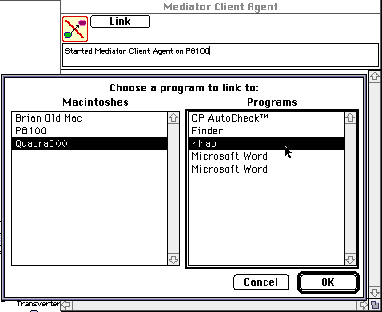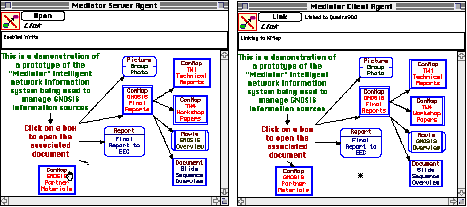
The general semi-formal diagrams of concept maps provide a very attractive basis for collaborative brain-storming and discussion. We have used the initial, non-networked version of KMap in learning situations with small groups developing conceptual frameworks collaboratively by working together on the same concept map. We have also found it useful for one learner to take the concept map of another, modify and extend it, and then enter into a group discussion about what changes they have made, and why. We have also linked KMap to repertory grid tools so that nodes representing a set of related examples in a concept map may be used to elicit a relevant conceptual framework through grid elicitation (Shaw and Gaines, 1992).
The scripting and communication capabilities of the class library in which KMap is implemented make it possible to provide explicit support for both synchronous and asynchronous collaboration over local and wide area networks. For example, Figure 20 shows the Mediator (Gaines and Norrie, 1994) collaborative concept mapping system when a user has opened a blank concept map with a script supporting client agent functionality. The user clicks on the "Link" button and a dialog box appears allowing her to select KMap running on her colleague's machine.

Figure 20 Linking concept map clients and servers across a network
When she does so her KMap requests a server agent running on the other machine to transmit a concept map of its top level data structures as shown in Figure 21.

Figure 21 Concept map fetched from a server agent
The cursor has changed from an arrow to a star at the lower right of Figure 21 to indicate that the concept map is not editable. The user can double-click in the window to make the map editable, changing the cursor back to an arrow. If the same concept map is open on the server machine this action will automatically make the remote map non-editable. Changes made to the editable map are transmitted to any linked ones. Figure 22 left shows a node of the map on the server being dragged to the left, and the change occurring in the linked map on the right.

Figure 22 Changes to the concept map on one machine are transmitted to the linked map
Figure 23 shows a screen dump of a sequence of material being accessed from the concept maps in Figure 22. The map is shown at the upper left currently write-disabled, and the cursor has changed to a button as the user mouses over the "Group Photo" node. Clicking at this point will display the photograph in a separate window. The user has already clicked on the node "GNOSIS Final Reports" to open the concept map shown at the lower right. This has a node for each report, and clicking on one will open the appropriate report. The user has already clicked on the "TW4 Workshop Papers" node in the concept map at the top left, and opened the relevant concept map at the bottom left. She has then clicked on the node "Click here to see the report in Replica", and opened the report visible at the back on the right. She has also clicked on the "Click here to see all the movies" node and opened the document visible behind the concept maps which displays QuickTime movies, any of which can be played by double clicking upon it.

Figure 23 Accessing networked hypermedia materials through layered concept maps
Thus, the scripting and communication capabilities of KMap may be used to create a collaborative environment for the editing of concept maps and their application to tasks such as indexing distributed hypermedia materials. The overall architecture of the Mediator system supporting the application illustrated in Figure 23 is shown in Figure 24. The "Server Agent" and "Client Agent" are implemented in KMap scripts. A server agent manages the relevant files at its site, providing a top-level concept map indexing the files through layers of concept maps that access other concept maps or files specific to some other application. A client agent links to a server agent at a remote site, and emulates the behavior of the remote server agent at the local site.

Figure 24 Mediator architecture supporting networked hypermedia access
When application specific files are fetched they are opened in the relevant application. If the application has functionality to support integration with other applications then it may pass messages back to the client and server agents. An example is the integration with Netscape (1995) described in the following section.
gaines@cpsc.ucalgary.ca 22-Nov-95